Hello friends! We have already published on Geektimes a small preview of our VR helmet Lenovo Explorer. But then it was just a brief acquaintance with the device, and now we want to share detailed impressions of the long experience of using the gadget. And using the example of this review to show that a long period has finally passed, when everyone said that VR, they say, is an interesting thing, but it’s too early to buy helmets. That's right now, it's time!
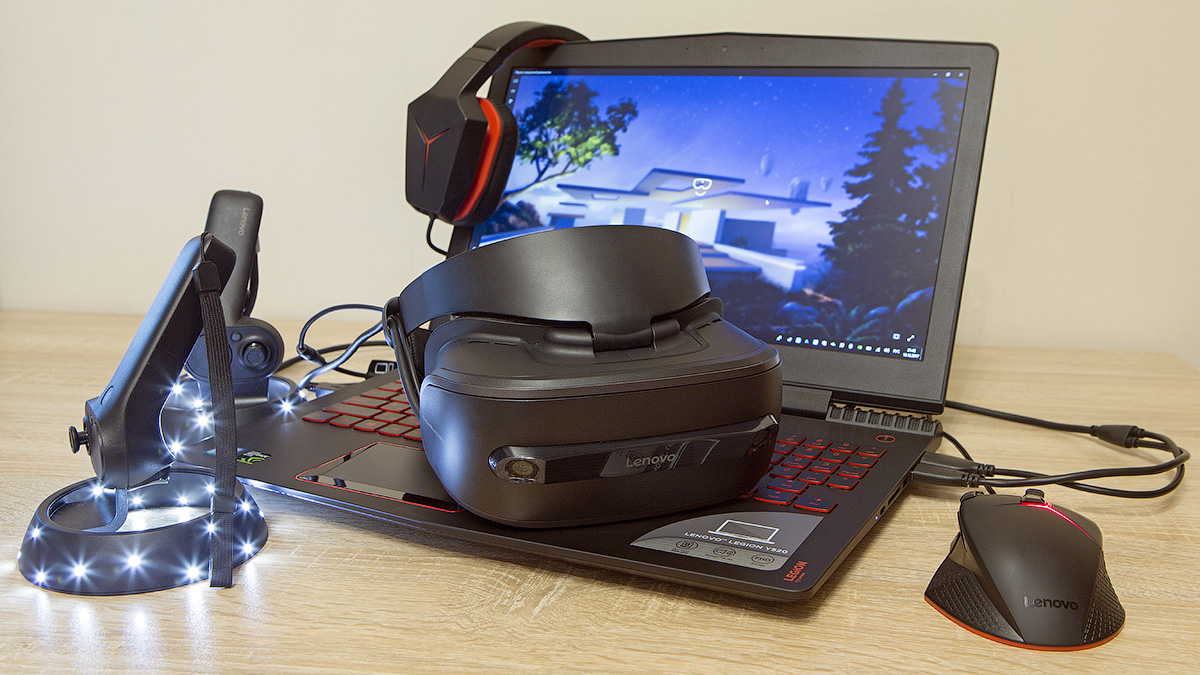
Why is it time? Because the Windows Mixed Reality platform with Steam VR and VR headset support for it, including Lenovo Explorer, is such a comprehensive pass-through ticket to the world of virtual reality for mainstream users. That is, for everyone who is looking for new sensations and impressions, but is not ready to bother with tuning and searching for a specific technique.
And this is normal: time is now - a thing absolutely priceless. With Lenovo Explorer, everything is easy: go to the store, buy a helmet, connect to a computer, set up in 5 minutes according to extremely simple and understandable instructions right inside Windows ... and then you just have to bring up fresh games and programs from application stores. But first things first.
Appearance and convenience
Lenovo Explorer - a helmet very thoughtful. First of all, we tried to reduce weight as much as possible, and in the end we got one of the easiest solutions in its class: the device weighs 380 grams.

Then they added thick, soft linings for the forehead and the back of the head, and a convenient long mount, with which the gadget can be firmly and firmly fixed on the head.

Physical training is different for everyone, of course, but so far very few people have complained that after long (from half an hour or longer) game marathons with Explorer on their head, their neck is tired.

If suddenly you need to distract from virtual reality, then you do not need to remove Lenovo Explorer. For a quick return to the real world, you can simply lift the main part of the helmet upwards as it was with one stroke. It is convenient if you need to change something in the system settings, start another game or if someone came to the room to talk with you.
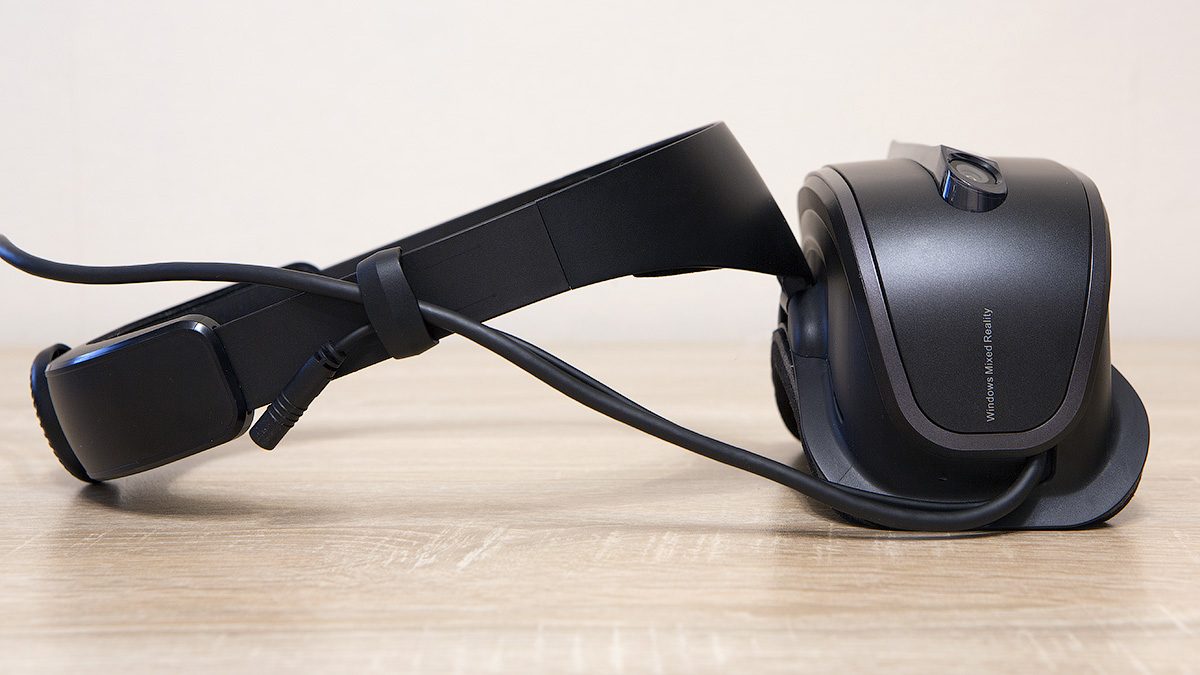
The next item may seem controversial for someone, but we and many users, whose reviews we have heard, seem logical. We are talking about the rejection of the built-in headphones. This makes it easier for the gadget and allows those who have their own good headphones to use them. And many of them are not needed at all - there are enough speakers in the room.
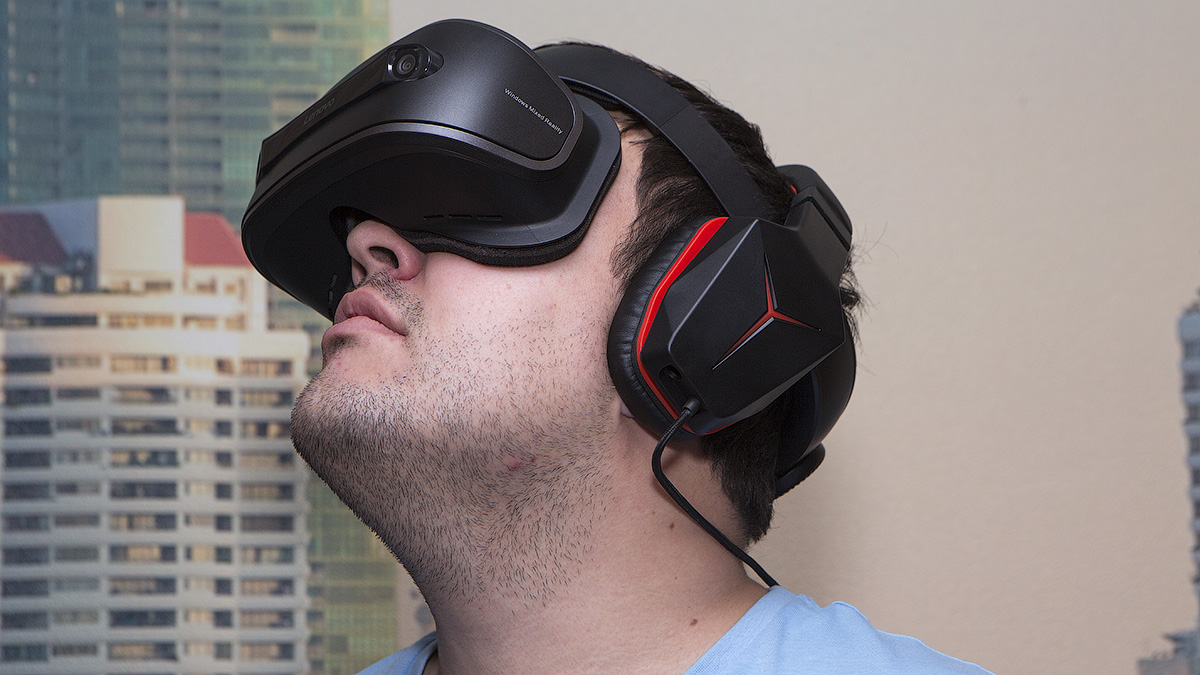
To connect headphones, an audio jack is provided on the short wire (for mobility) on the right side of the Explorer.
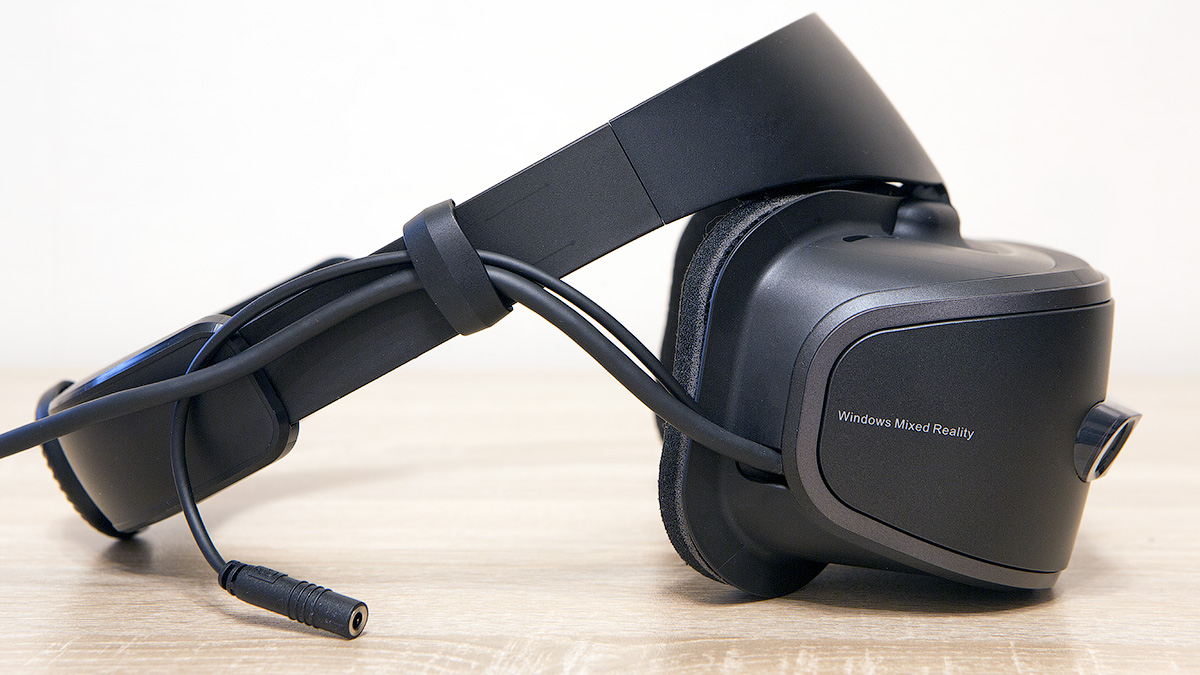
Go ahead. Users with long-sightedness and myopia with wearing VR helmets often have big problems. Not everyone is wearing contact lenses, just like not all helmets can be worn over glasses. Lenovo Explorer among those few VR-devices that are easily combined with glasses. The main thing is to ensure that the lenses of the glasses and the helmet do not rub against each other, just in case.
Now a few words about connecting to a computer. For this you need only a connector: HDMI and USB. If you do not have a desktop, and you use a gaming laptop, then this is definitely good news. By the way, this is how we tested the helmet - in conjunction with the Lenovo Legion Y520 with an Intel Core i5-7300HQ processor and GTX 1050 Ti graphics. Cord length - 4 meters. For use inside an ordinary Russian apartment - just right, even with some margin.
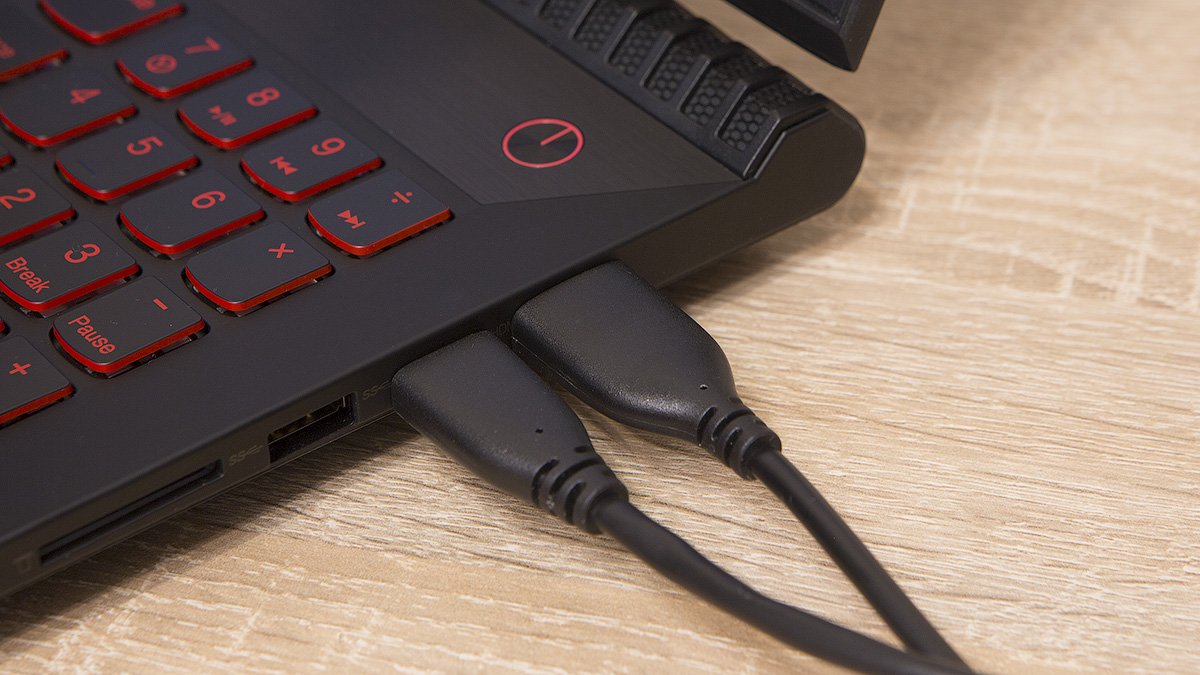
And finally, the controllers. First, they are included in the default package. Secondly, with their activation everything is also extremely simple - the helmet finds them and determines the positioning in space automatically, but more on that later. In the meantime, about the controls, which are six. Four main: trigger, stick and button for the middle and thumb. The latter also has a built-in touch panel. Plus two extras: a power button with a Windows logo and a small menu key.
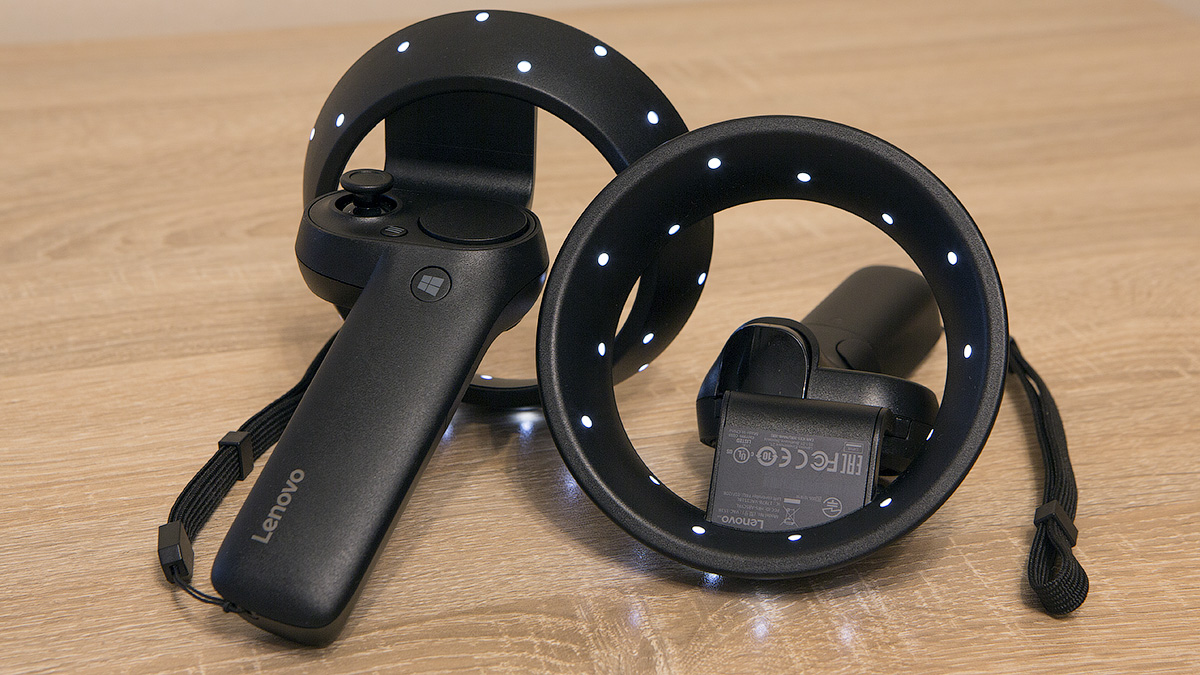
For each of the controllers require two AA-batteries. Time for addiction is practically not required. Within five minutes after you first take controllers in hand, you will master all the nuances of working with them thoroughly. Again, tested on so many "subjects."
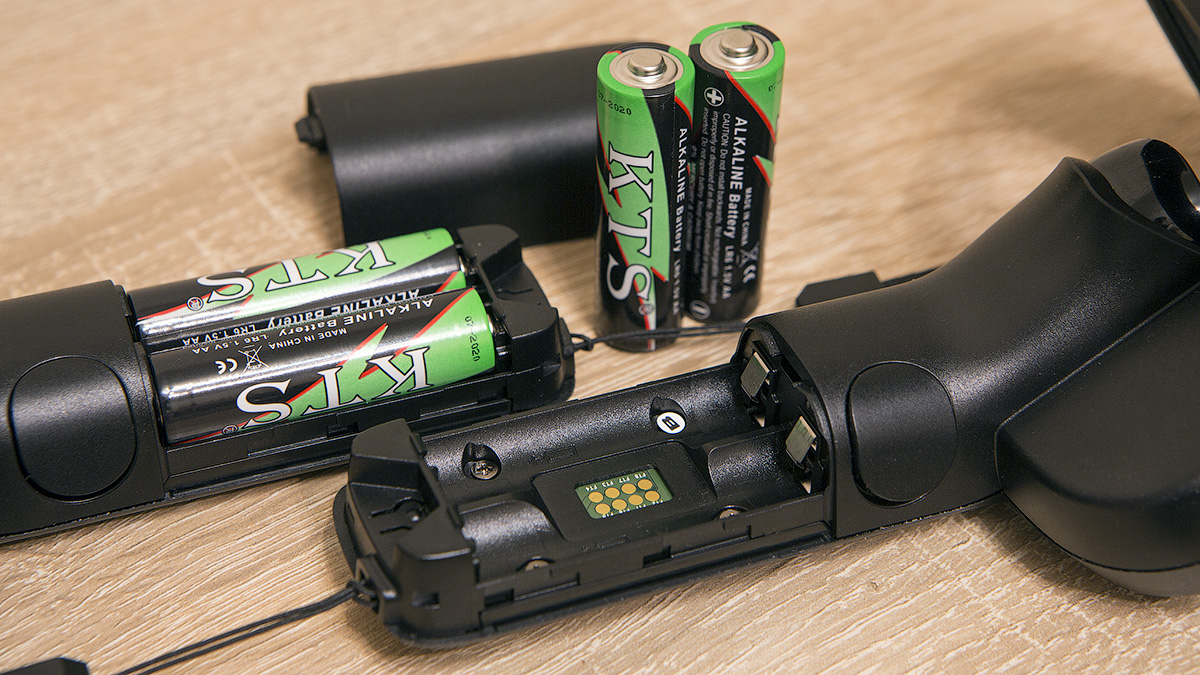
The principle of the helmet
Lenovo Explorer doesn’t need tricky sensors or any special calibration. With the positioning in space, the helmet is remarkably well-disassembled “by itself” with little or no user assistance. Only for the very first time you need to spend 30-40 seconds on its simple calibration - to outline the approximate boundaries of the room in which you plan to use it.
Responsible for this positioning is a set of integrated sensors and two cameras. They also monitor the movements of the controllers: just for this, 18 bright diodes are built into each of them. But if the controllers suddenly disappear from the zone of visibility, it does not matter - they also have their own sensors. During dynamic games, switching between the way of tracking joysticks is not noticed at all - everything works exactly and smoothly.
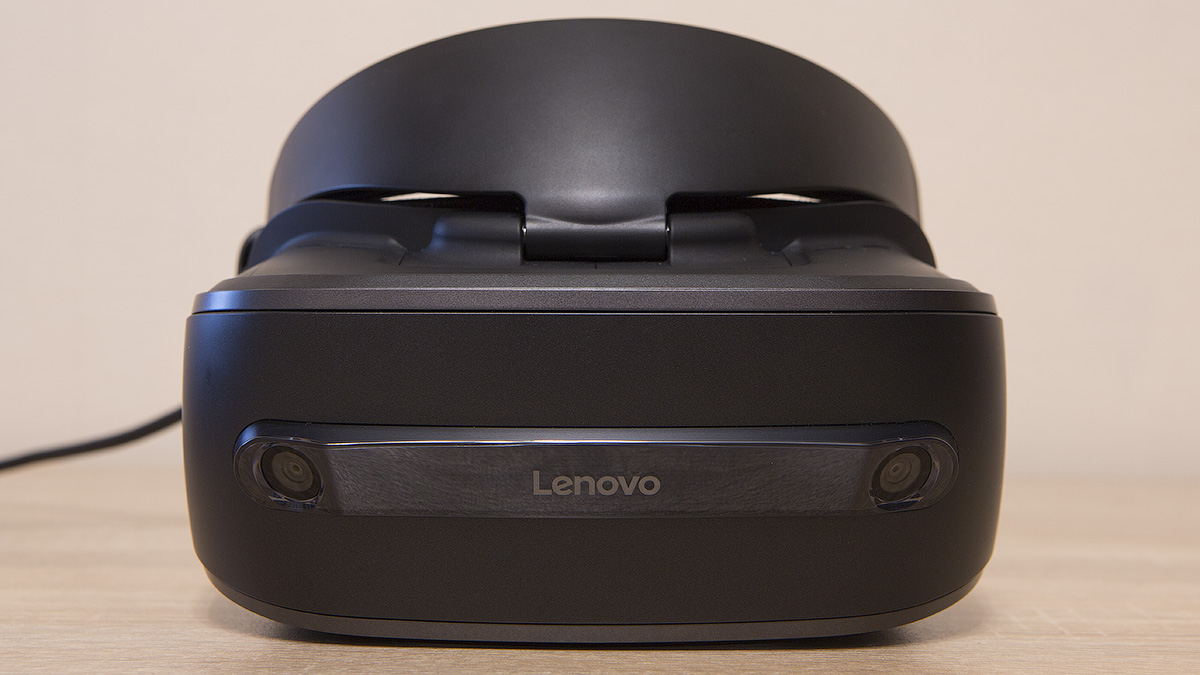
Details on the configuration process
One of the main advantages of Lenovo Explorer is the absolutely elementary configuration process. It would be possible to say that even a grandmother will cope with this, but only if she knows how to update Windows 10. So, perhaps, we’ll confine ourselves to someone like a junior schoolboy. Actually, let's start with the operating system update.
First of all, you need to upgrade to the Fall Creators Update version and download everything you need to download the auto-update utility. When the process is over, among these things there will be a thing called “Mixed Reality Portal”. We go into it and begin to follow the simplest instructions, which are accompanied by clear hints in the form of pictures with captions.
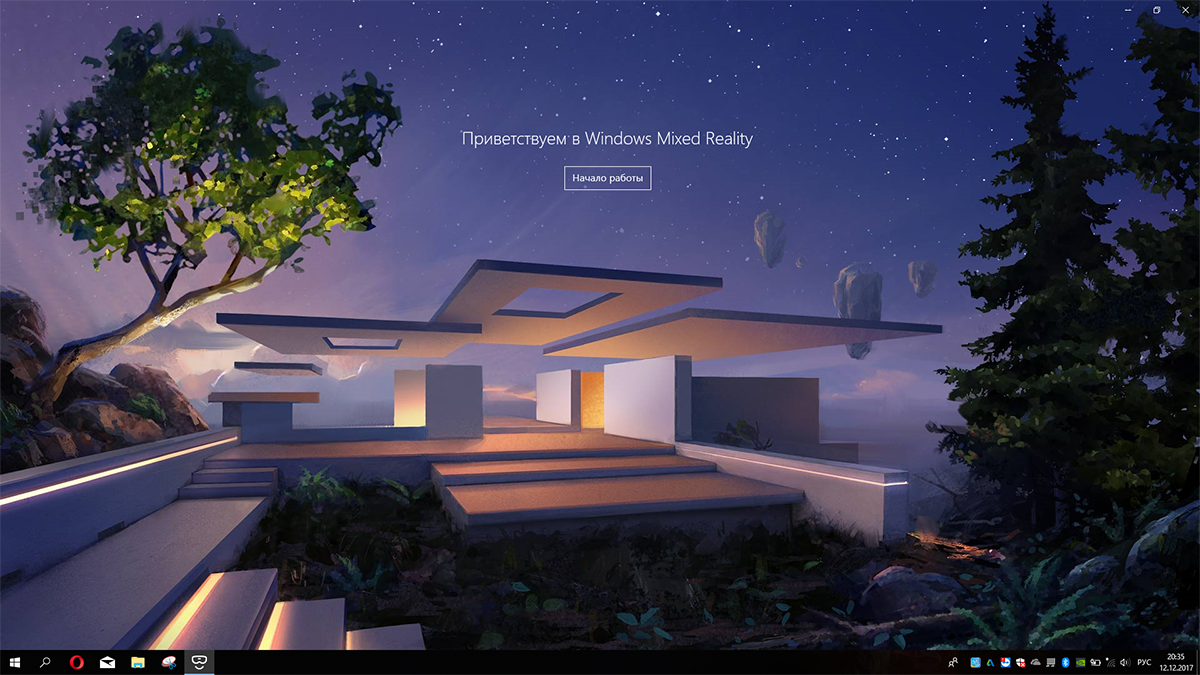
First, the program will determine the parameters of your system.
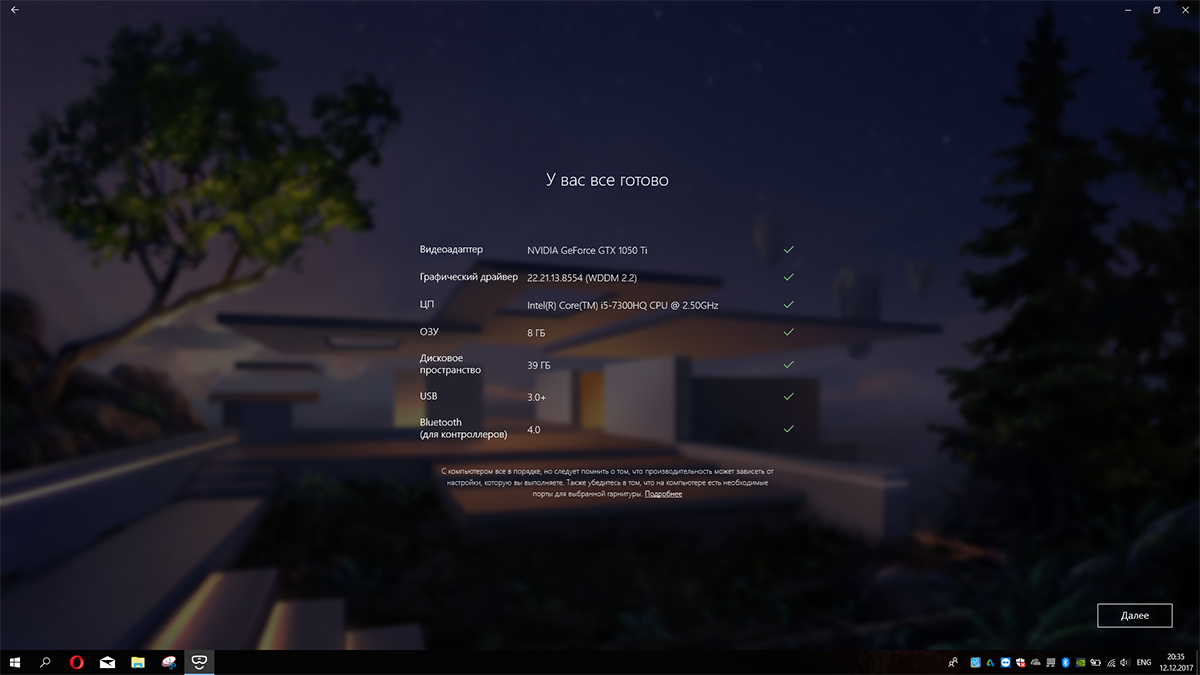
Then he will ask you to connect the VR helmet to the computer. After tell and show how to turn on the controllers. Keep in mind that they connect to the computer via Bluetooth, so if you have a desktop, then you need a transmitter.
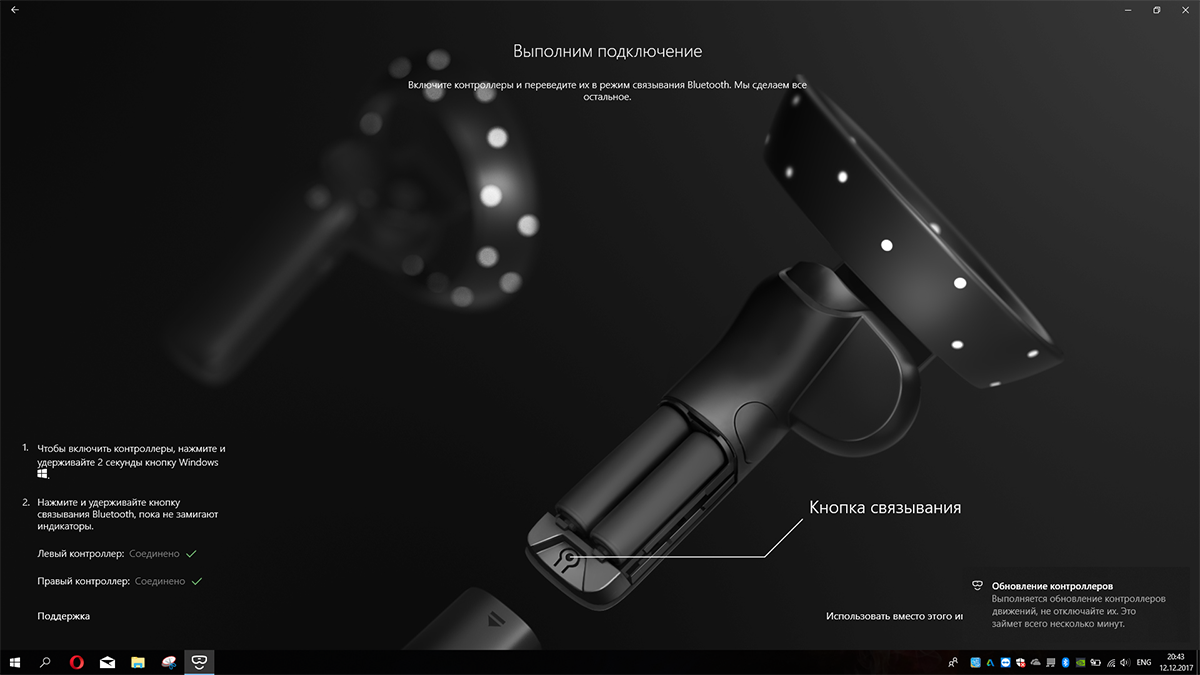
And, finally, he will ask to take the helmet in his hands, direct the cameras towards the PC monitor and walk with him around the perimeter of the room. So you designate a zone in which you can move freely during the games.
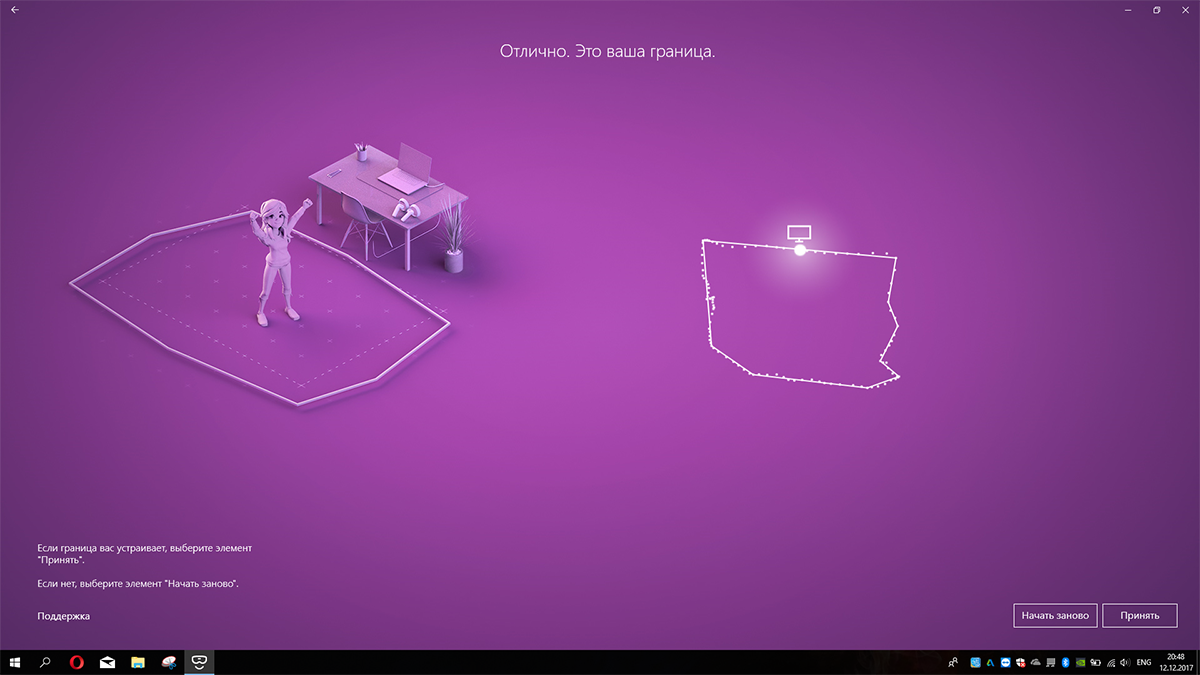
Here, in fact, the whole setting. It takes about 5 minutes. Well, or 10, if you read the tips especially thoughtfully.
Immediately after that, you get into the virtual interface of Windows Mixed Reality, where there will also be a short training. The program will tell you how to move in space using stick and teleportation and teach you how to select objects.
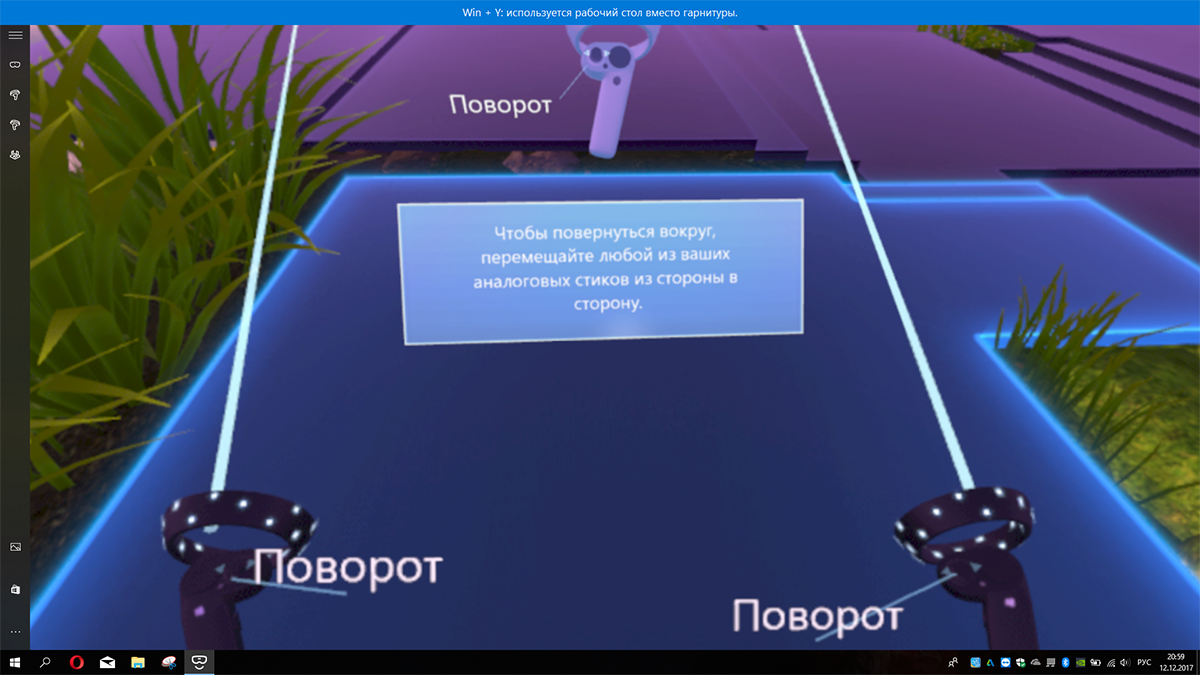
These skills are very useful when you equip a cozy house called Cliff House: arrange virtual interior and hang windows with different programs on the walls. Here, by the way, is the first advantage of VR: even the most common management interface is implemented in a very original way.
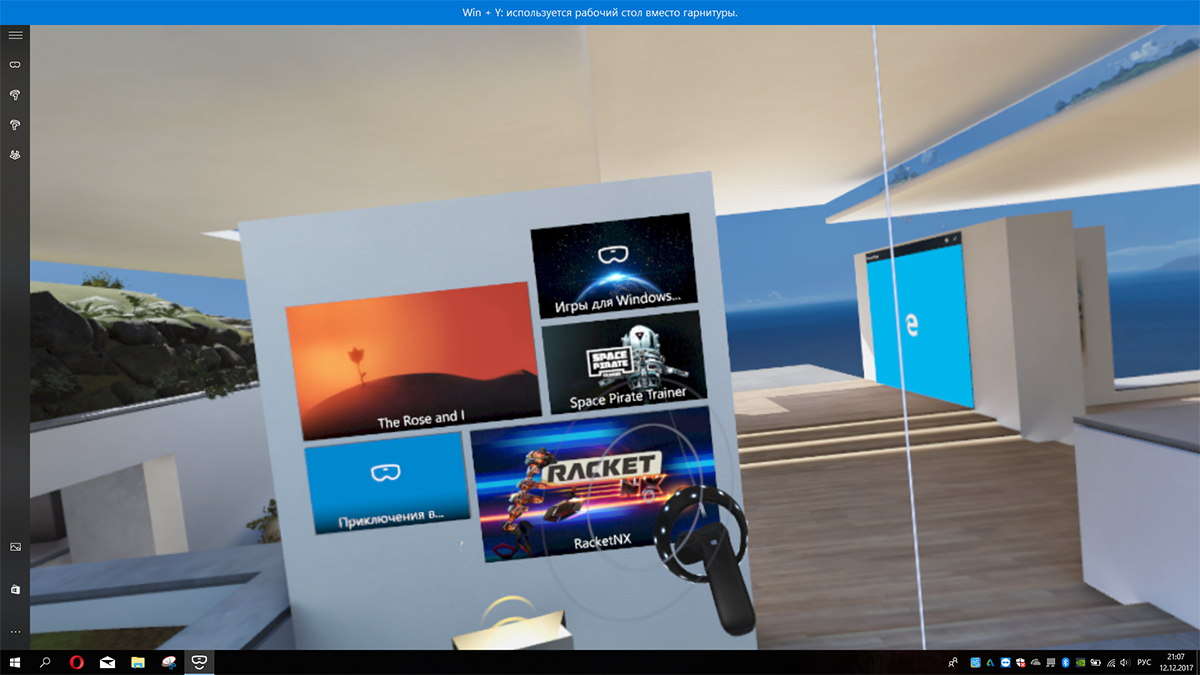
As a minus, probably, it can be noted that initially the house looks somewhat deserted. The simplest set of interior elements, though not carrying any practical use in the development of the VR-world, would definitely not be superfluous. Not everyone liked to play Sims. On the other hand, but what a space for creativity for those who liked the arrangement of a virtual house! This is not just a wallpaper for you to change.
What to play in VR?
Of course, Mixed Reality completely allows you to work with programs, but there are questions. There is still little software, plus users are not in a hurry to demand a VR version of Photoshop and, say, Premier Pro. On the whole, the question of their necessity remains open, although watching a movie with VR glasses is pretty good.
But the story of drawing in three-dimensional virtual space looks incredibly cool right now. While some are trying to find flaws in everything, others simply take controllers in their hands and create completely awesome things. See what cool fantastic flying thing with the help of Lenovo Explorer drew one of the visitors of CG Event Moscow 2017:

But the most important thing is, of course, games. They were registered in virtual reality for a long time, seriously and for a long time. Now they are the driving force of the entire industry and will remain so in the coming years. So what about them and talk.
The most important thing before buying a VR helmet is the understanding that AAA class projects, unlike PCs and consoles, are still not enough for these gadgets. If you prefer only the "top" games, then, probably, it really makes sense to delay a little more with the purchase. But if you are not afraid to discover new things for yourself, then the expanse is wide now.
If we talk about the assortment of the Microsoft Store, then the absolute favorite is, of course, the Super Hot game. Action with tricky mechanics, in which enemies move and perform actions only when you do it, has gained immense popularity. Dodging bullets like Neo and smashing ashtrays to the heads of the enemy is great.
There is also a very good and dynamic zombie shooter Arizona Sunshine.
And a great game Space Pirate Trainer, in which you need to shoot nimble drones and dodge their laser beams. By the way, a great substitute for traditional morning exercises!
Another unexpected find is Skyworld, a cartoon project in which developers have successfully combined elements of turn-based strategy and RTS.
However, it is understandable that avid gamers are not primarily interested in the Microsoft store, but the declared compatibility of Mixed Reality helmets with SteamVR - the most “tasty” to date has been collected there. We report: no one deceived anyone. Compatibility (as long as in beta mode) really exists: with SteamVR Mixed Reality and Lenovo Explorer became friends on November 15th, and since then this friendship has only grown stronger.
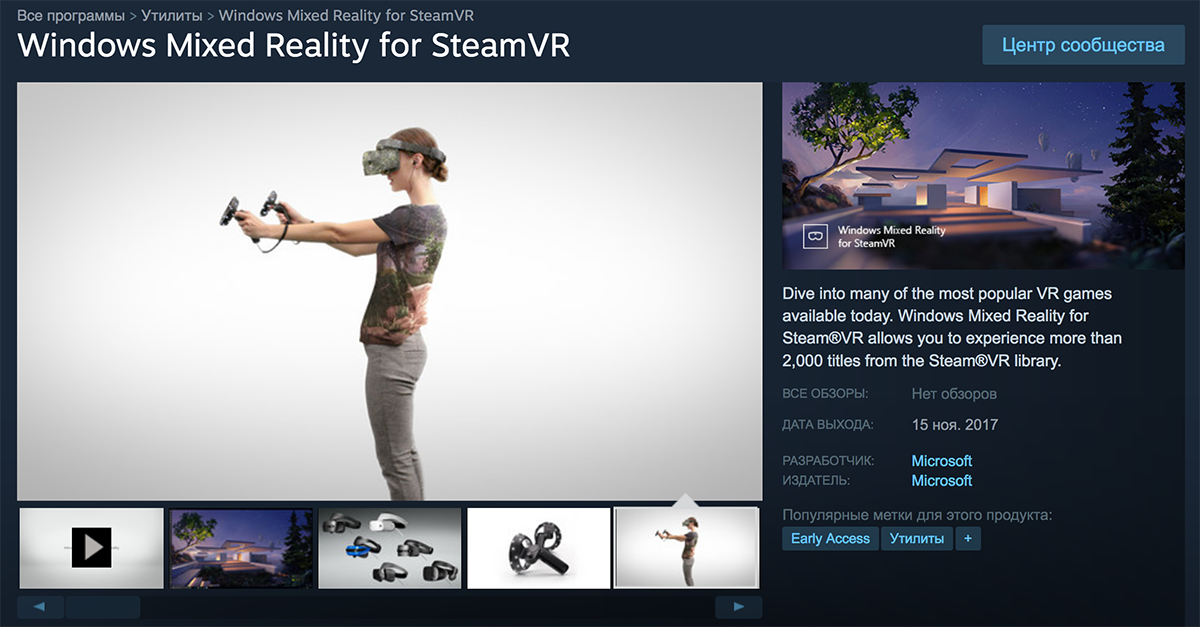
However, the setting here is not automatic yet. But her algorithm is also nothing complicated. Just in case, let's describe it step by step here, because for some reason no one has yet translated the instruction into Russian. Well, either we just did not find the translation.
Steam setting- Update Windows 10 to Fall Creators Update and perform the initial setup of Lenovo Explorer, which was described in detail above, if you suddenly did not.
- Go to your account on Steam and download SteamVR.
- Go to the tab "Library" and select the section "Tools".
- In the long list we find SteamVR, click on this item with the right mouse button and select "Properties".
- In the window that appears, go to the tab "Beta-version" and instead of the option with refusal to participate in beta programs give our consent to it.
- After this, SteamVR will automatically download additional files and install them.
- Next, go to the Windows settings. We need the item "Update and Security."
- On the “For Developers” tab, select the “Developer Mode” option and wait until the operating system also loads several files and installs them.
- We return to Steam and download the free Windows Mixed Reality for SteamVR program from the store.
- Go directly to the launch of VR-games. To do this, first turn on the Windows Mixed Reality program and wait for the Cliff House interface to appear. Then go to the window with Steam and run any of the already loaded VR games. It immediately opens automatically in Windows Mixed Reality. You can wear a helmet and begin to have fun.
Of course, for now it is not very convenient to go through this list and perform all actions. But this is only needed once. In addition, a few weeks ago more operations had to be performed. Actually, the beta for that and beta to confidently move to the most simple final version. It seems that her appearance is a matter of the next few months.
There is no secret that in the Steam store, the assortment of VR games supported on Lenovo Explorer and other Windows Mixed Reality helmets is much more. At the moment, the number of available options is close to a hundred and fifty. We recommend paying particular attention to the extremely high-quality multiplayer cooperatives Climbey and Rec Room, the truly frightening Dreadhalls, the adventure game FORM and the QuiVr archery simulator. It’s quite enough to keep busy with something, as the recently released Doom VFR and Fallout 4 VR also adapt for Windows Mixed Reality helmets.
By the way, here you have a funny fact. Some of our employees brought Lenovo Explorer home to thoroughly familiarize themselves with the new product. And then miracles happened. Their relatives, who had previously only looked reproachfully at the shooting at the monitor, began to be seriously interested in what was happening and also asked to try on a helmet. And they got involved! Even simple projects to demonstrate the capabilities of VR from the same Steam, such as free Waltz of the Wizard and Guns'n'Stories, drove them into complete delight.
By the way, for Guns'n'Stories, support for Mixed Reality helmets is not stated, but the game worked fine on Lenovo Explorer. And this is an obvious hint that it is worth trying to launch other similar VR projects, of which there are as many as 67 pages on the Steam list!
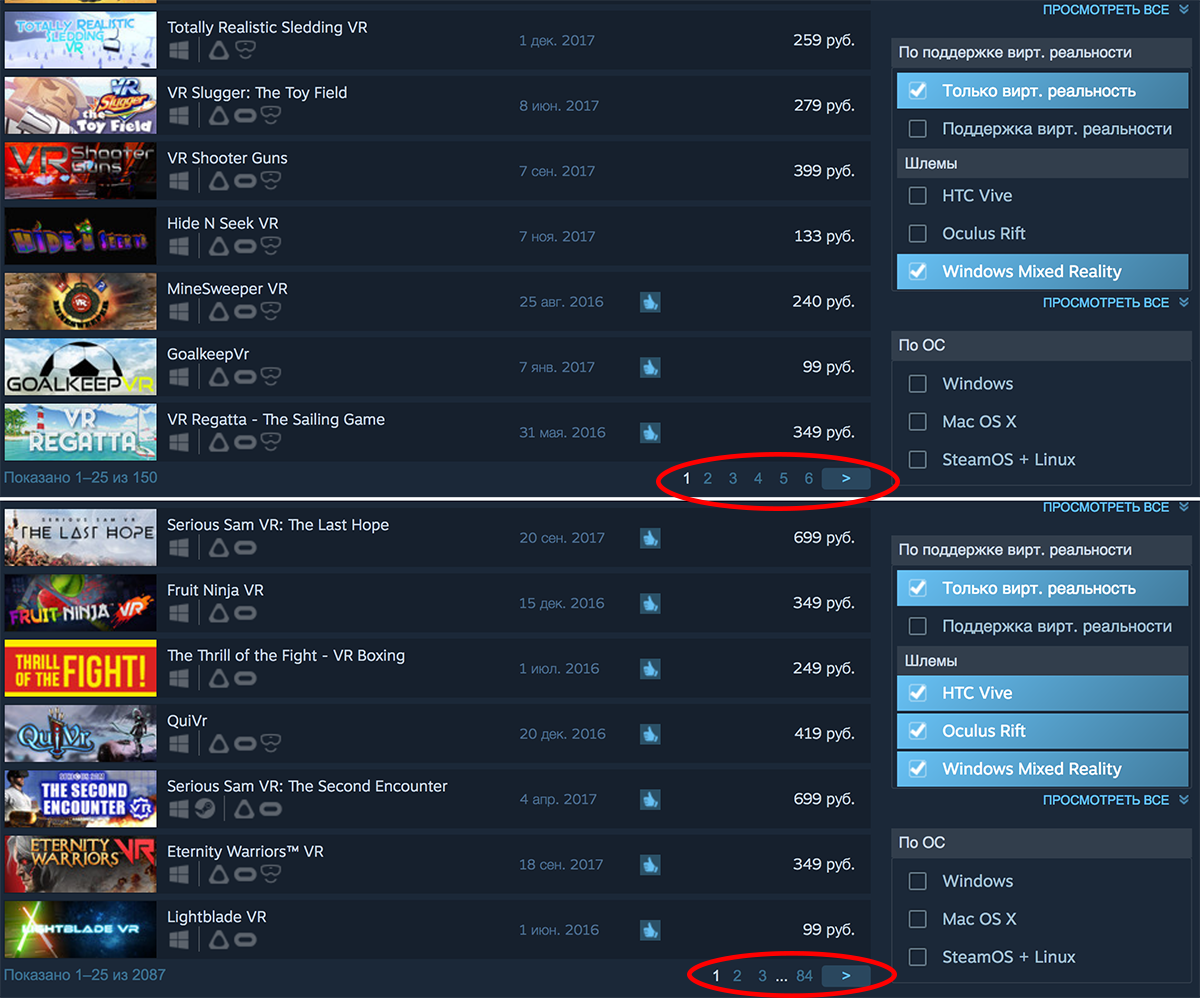
About image quality and technical requirements
A separate important point about which you need to talk in detail is the quality of the image in the helmet. Inside it are two LCD displays with a resolution of 1440x1440. As a result, before your eyes you see a picture in the size of 2880x1440 pixels.
Given that the displays are very close to the eyes, the perception of the pixels here is quite different than, for example, when you look at a smartphone or TV. Yes, some points are noticeable, but practice shows that you can only think about it during static scenes. As soon as at least some kind of dynamic appears, you completely stop paying attention to this. And then you get used to it. Plus, whatever one may say, but so far absolutely everyone has a “grain”.
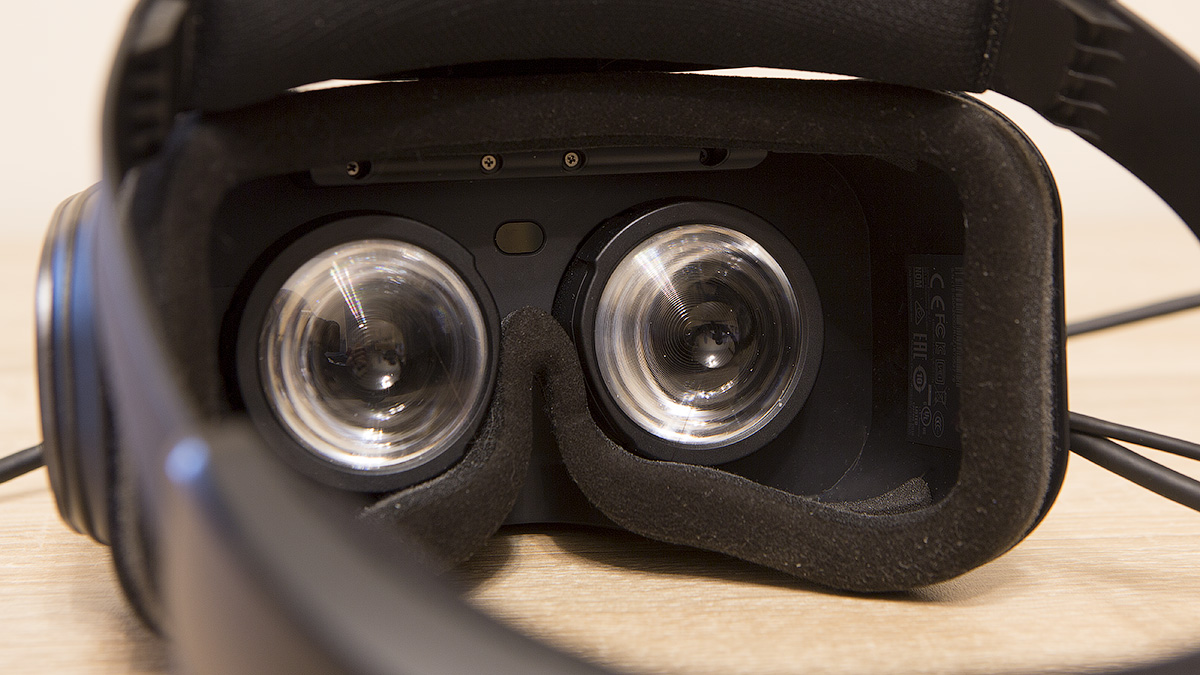
There is complete order with brightness: the feeling that a neutral gray filter was hung in front of our eyes, as sometimes happens, is not. The viewing angle is 110 degrees. With sharpness, everything is also normal, and it primarily depends on how tightly and comfortably you place the Lenovo Explorer on your head. Before the start of a long game, it makes sense to devote a few minutes to this process, and not just put a helmet on your head and continue to correct it constantly during the shootings.
Technical requirements are far from evil, as is commonly believed. Personally, we absolutely comfortably played Super Hot, the Space Pirate Trainer and a lot of free demos from Steam on a laptop with an Intel Core i5-7300HQ and a mobile GTX 1050 Ti.
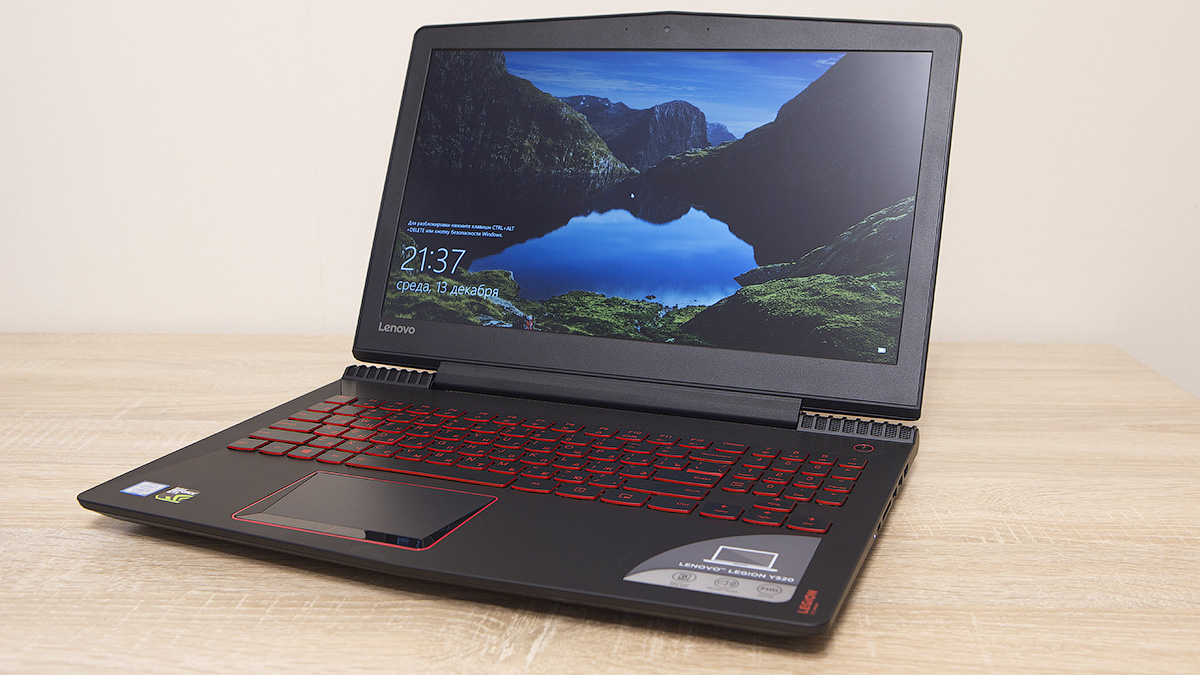
Perhaps Doom VFR, Fallout 4 VR and other similar projects will make some big requests to the hardware, but we can't say for sure yet - we haven't checked it. Well, once the “notebook” GPU and CPU are far from the top level, then the desktop i5 and GTX 1050 Ti or, moreover, the GTX 1060 with 6 GB of memory will be enough. It is this combination of processor and video card that is most often used in most game assemblies of the average level for 40-60 thousand rubles.
Well, if we talk about working in programs, watching movies, going to virtual museums, launching VR tutorials, then there will be no more than a PC with seventh generation i5 / i7 processors with integrated graphics.
Summary
Who is Lenovo Explorer best for? In our opinion, the gadget is most liked by the fact that it has already assembled a more or less modern computer or bought a gaming laptop, has long gone through all the actual PC gaming releases of the year and is now in search of new virtual entertainment. That VR is able to give them: in the Steam assortment, there are really a lot of different and interesting games in virtual reality. And the farther, the more they will be.
Well, Lenovo Explorer can be purchased at our official online store or in M.Video at a price of 39,990 rubles. By the way, a great gift to yourself beloved for the New Year.